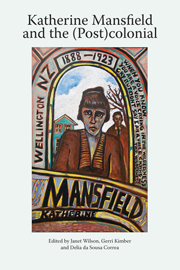Book contents
- Frontmatter
- Contents
- List of Illustrations
- Acknowledgements
- Colophon
- Introduction
- Criticism
- Katherine Mansfield: Cannibal
- Mansfield as (Post) colonial-Modernist: Rewriting the Contract with Death
- Colonialism and the Need for Impurity: Katherine Mansfield, ‘The Garden Party’ and Postcolonial Feeling
- ‘How Katherine Mansfield was Kidnapped’: A (Post) colonial Family Romance
- ‘Unmasking’ the First-Person Narrator of In a German Pension
- Workmanship and Wildness: Katherine Mansfield on Edith Wharton's The Age of Innocence
- Home and Abroad in the South Pacific: Spaces and Places in Robert Louis Stevenson and Katherine Mansfield's Short Fiction
- Literatures of Expatriation and the Colonial Mansfield
- Creative Writing
- Reports
- Reviews
- Notes on Contributors
- Katherine Mansfield Society
‘How Katherine Mansfield was Kidnapped’: A (Post) colonial Family Romance
from Criticism
Published online by Cambridge University Press: 05 March 2014
- Frontmatter
- Contents
- List of Illustrations
- Acknowledgements
- Colophon
- Introduction
- Criticism
- Katherine Mansfield: Cannibal
- Mansfield as (Post) colonial-Modernist: Rewriting the Contract with Death
- Colonialism and the Need for Impurity: Katherine Mansfield, ‘The Garden Party’ and Postcolonial Feeling
- ‘How Katherine Mansfield was Kidnapped’: A (Post) colonial Family Romance
- ‘Unmasking’ the First-Person Narrator of In a German Pension
- Workmanship and Wildness: Katherine Mansfield on Edith Wharton's The Age of Innocence
- Home and Abroad in the South Pacific: Spaces and Places in Robert Louis Stevenson and Katherine Mansfield's Short Fiction
- Literatures of Expatriation and the Colonial Mansfield
- Creative Writing
- Reports
- Reviews
- Notes on Contributors
- Katherine Mansfield Society
Summary
Introduction: ‘How Pearl Button Was Kidnapped’ as Künstlerroman
Mark Williams and Jane Stafford, who approach Katherine Mansfield's problematic relationship with her national background from a post-colonial interest in ‘Maoriland writing’, have recently proposed that instead offocusing exclusively on the many turning points in Mansfield's career, readers should also consider the impressive continuities within her literary production:
The common view that Mansfield became a major modernist writer by staging a break from the provincial colonial culture of early 1900s New Zealand rests on a series of binaries – modernity versus tradition, province versus centre, national versus cosmopolitan, Victorian versus modernist – that ignore the continuities within Mansfield's writing from 1906 to her death seventeen years later.
This perspective allows Williams and Stafford to state that the departure of Mansfield from New Zealand in 1908 did not constitute the definitive catalyst of her modernism.
On the contrary, Mansfield's modernism often acknowledges its New Zealand origins through frequent references to a specific location in space and time, or to gender, as Keith Gregor notes in speaking of Mansfield's ‘female modernist aesthetics’. However, Williams and Stafford's concept of ‘continuities’ could be extended much further to refer not only to Mansfield's entire oeuvre, but also to embrace a more extensive literary and cultural debate.
- Type
- Chapter
- Information
- Katherine Mansfield and the (Post)colonial , pp. 63 - 75Publisher: Edinburgh University PressPrint publication year: 2013



